Programming Languages PartC Week2学习笔记——OOP(面向对象) vs FD(函数式)
@
OOP Versus Functional Decomposition
面向对象与函数式(或过程式)编程的分解对比
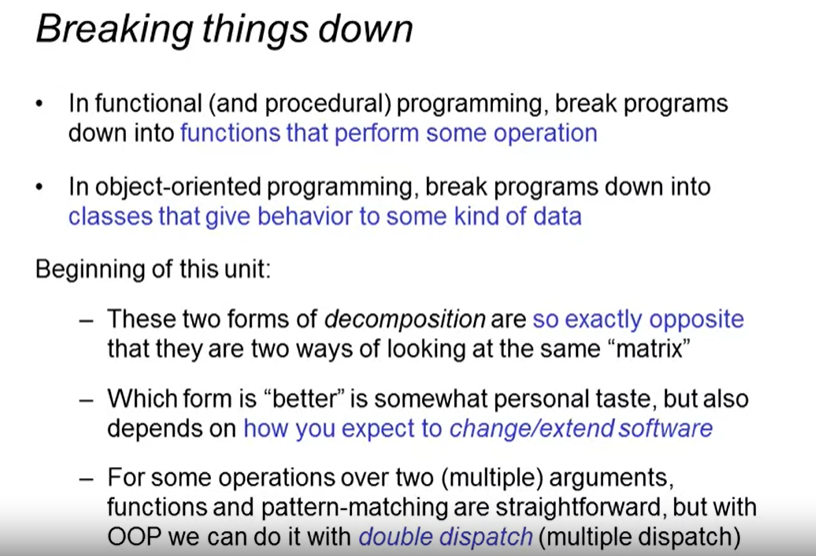
例子:不同的变量和操作构成了二维矩阵。
面向对象和函数式的思维方式不同。
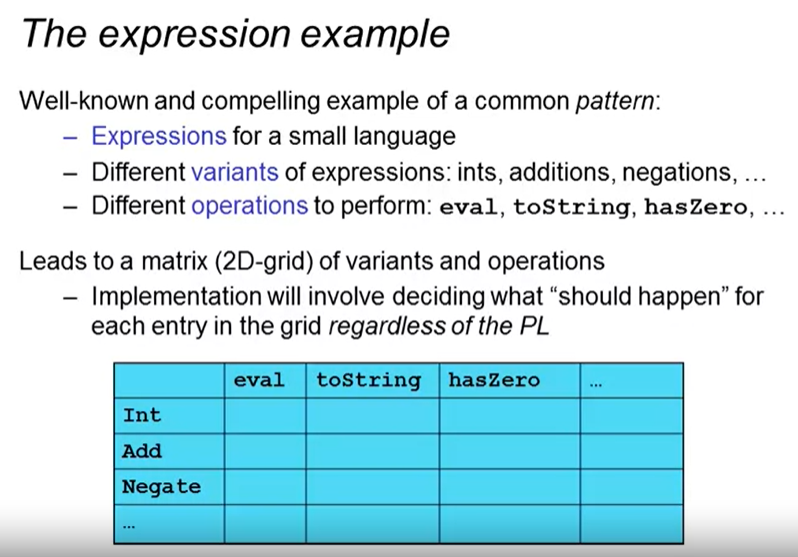
函数式编程的做法:通过函数填充每一列

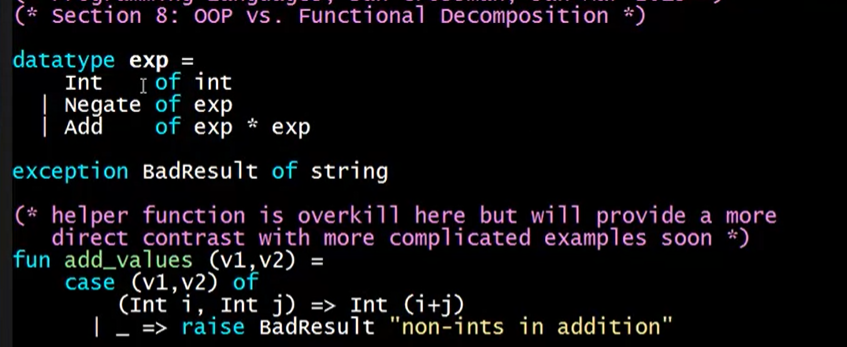
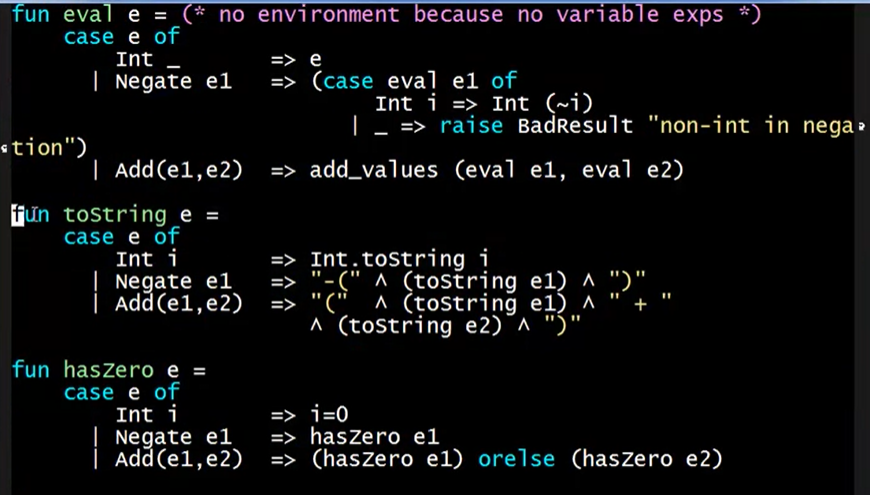
面向对象编程:通过类填充每一行
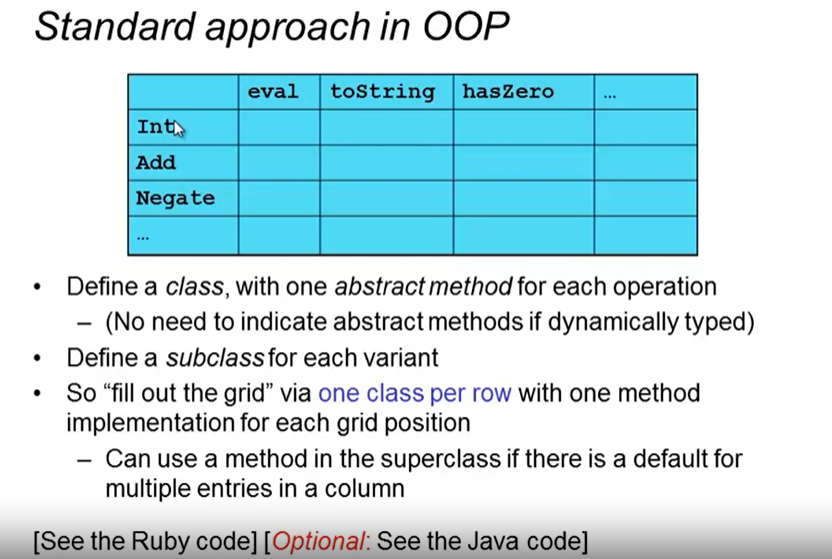
对Ruby而言:




对Java而言:
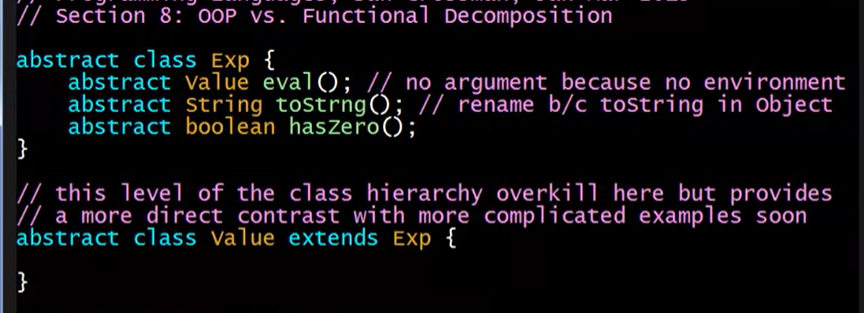
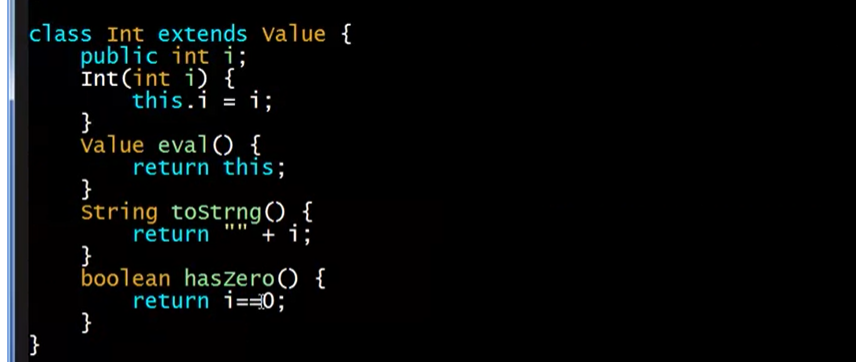


所以,事实上函数式编程FP和面向对象编程OOP都能做到同样的事情,但他们用了两种几乎相反的方式。具体使用什么方式,取决于做的事情和个人喜好。
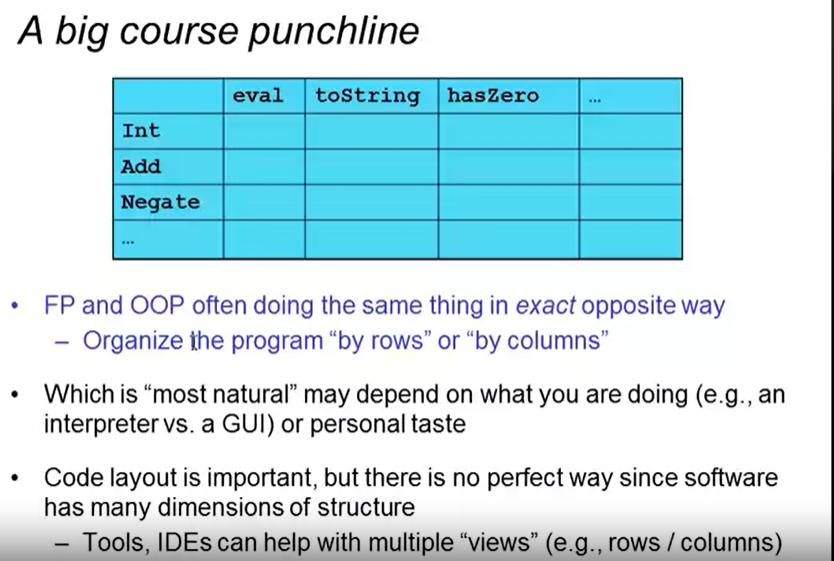
Adding Operations or Variants
这一节涉及到对已有程序的维护迭代。例如分别以FP和OOP的视角来看增加操作或变量。
对于FP:

代码中增加方法非常容易,只需要增加一个函数即可,但增加变量对象就相对麻烦一些,不仅需要在原有定义的结构中添加新的变量,而且需要修改前面定义的所有方法,让其适应新的变量。这很容易理解。


对于OOP:
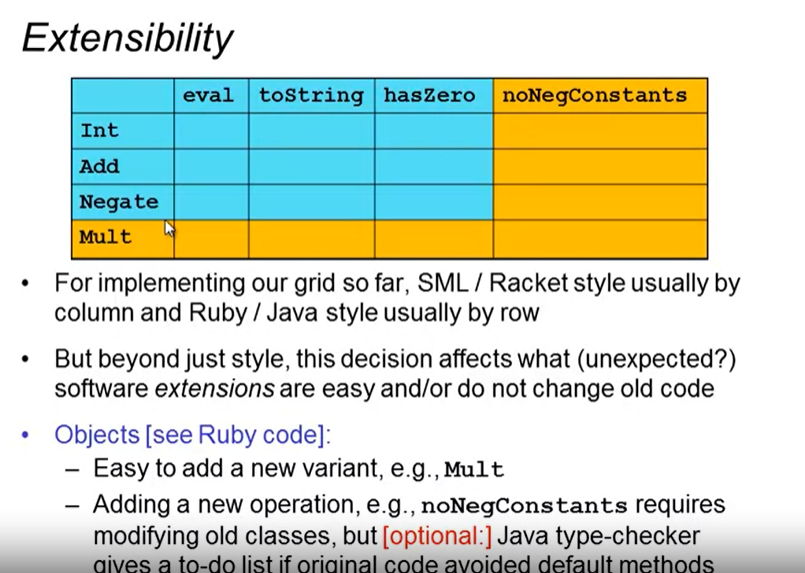
恰恰相反,添加一个变量只需要添加一个新的类(对象),但添加新的方法则需要修改已有的所有类(尽管可以使用继承或者一些设计模式来简化这一过程)。总之,也不难理解。
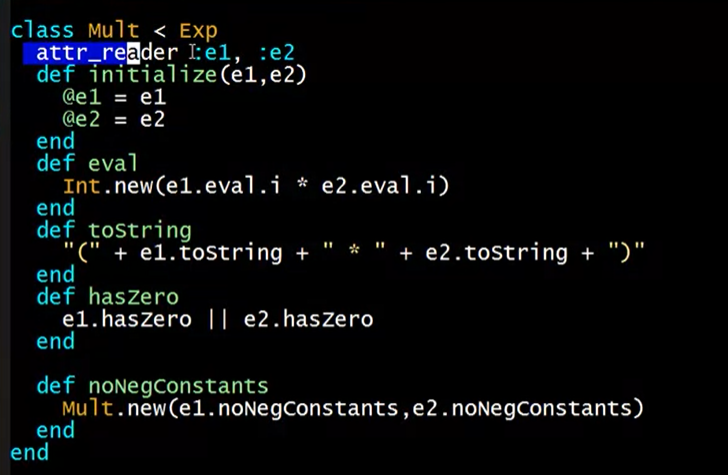
当然,我们总是希望能简化这个过程,让我们在使用某种方式编写程序(FP或OOP)时也能够使用另一种方式的优势(FP擅长新操作/方法,OOP擅长新变量/类)
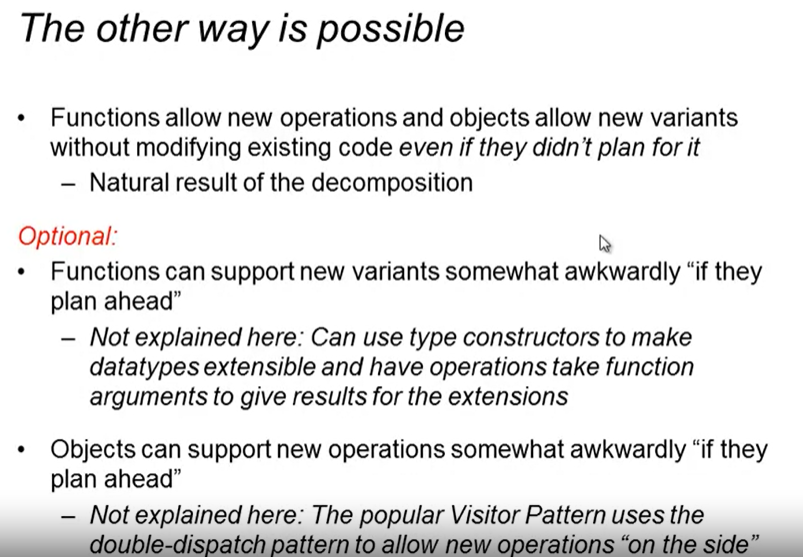
最后是关于程序扩展性的一些编程哲学。

Binary Methods with Functional Decomposition
假如有一个操作需要定义在众多参数(而不是某个单个变量调用)的基础上,例如二元操作

例子:这里的矩阵有所不同,不是变量Variants和操作Operation的关系,而是两个变量之间的关系。
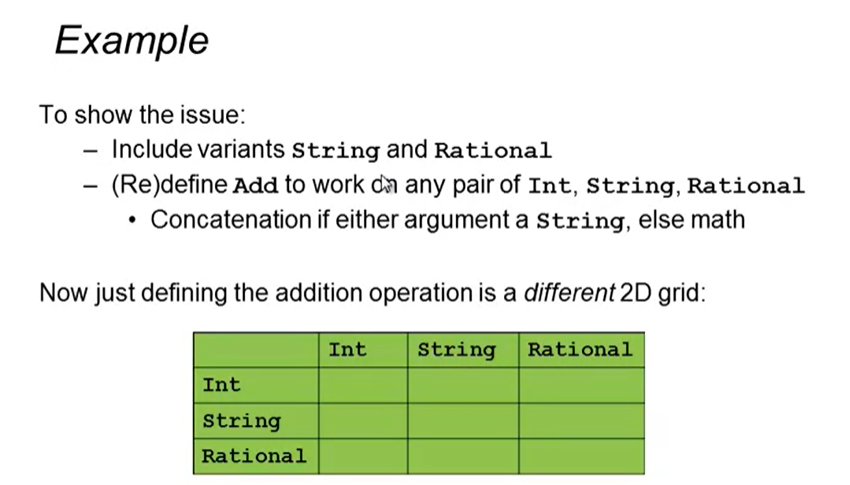
ML的例子:因为要处理各个变体之间的关系,Add就不需要抛出异常

我们的eval过程需要定义所有情况(函数分解),就像绿色矩阵中那样
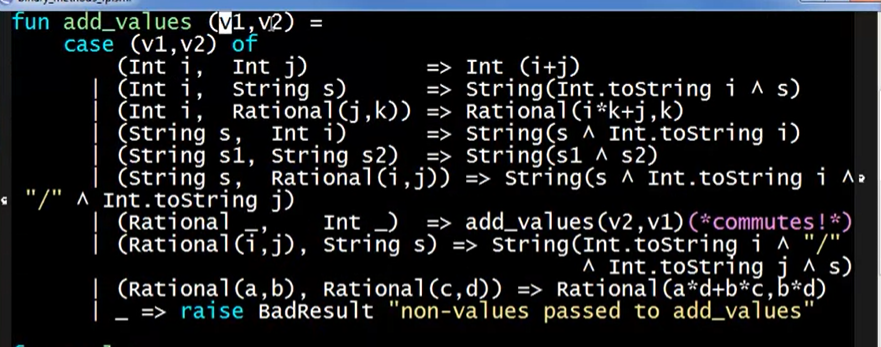
Double Dispatch
与上一节类似,本节要在Ruby中使用OOP的方式来实现类似的add_values操作,使用叫做双重分派的方式。
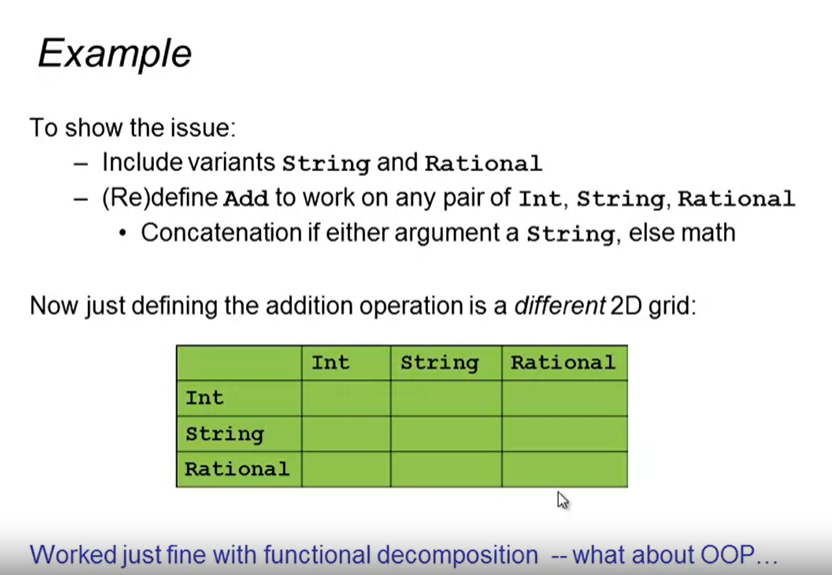
同样的,先定义数据结构,如下,Rational也类似。
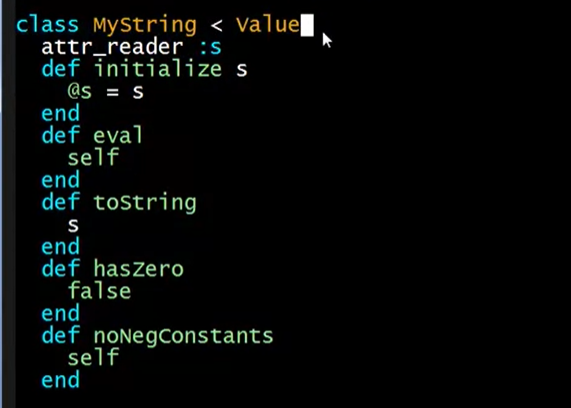
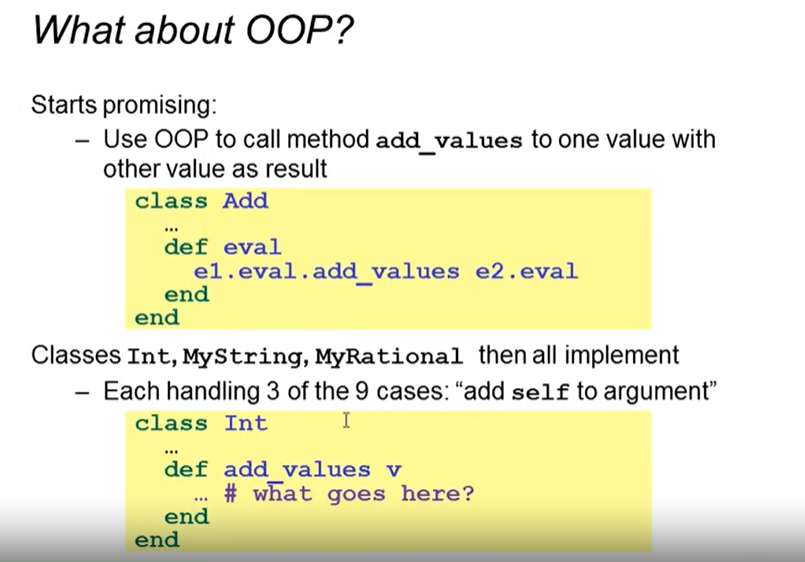
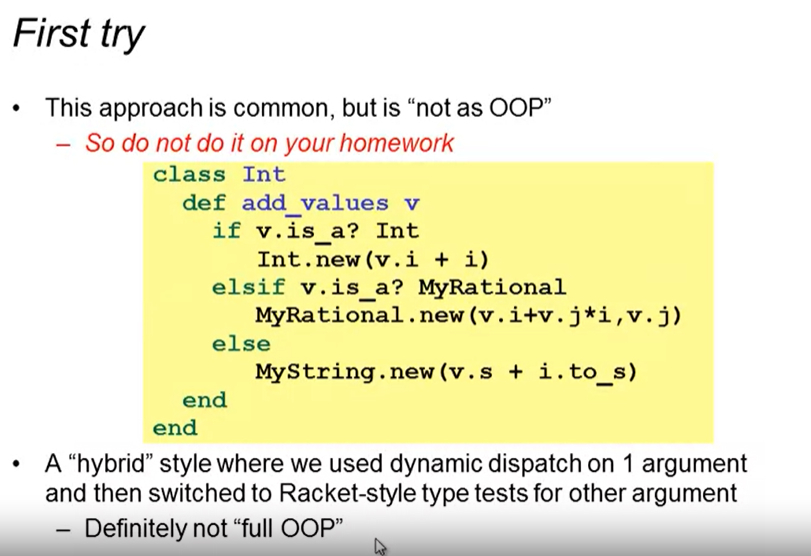
我们在某个类中总是需要识别其他对象的类,所以需要调用v对象的方法,但类似上述例子不是面向对象的方式(显式的判断v的类型)。我们确实需要“告诉”v,self是什么类型,这一点使用动态分派可以做到,这个技巧称为double-dispatch(即分派两次)。
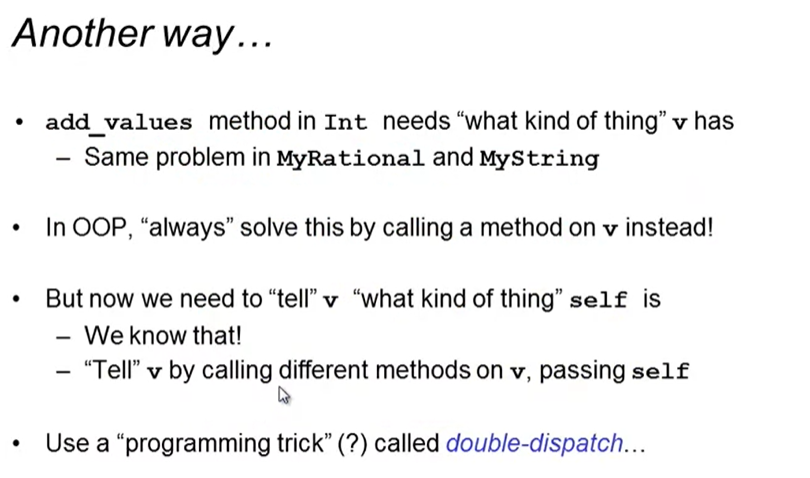
这里直接参考代码:
每个类仍然需要定义三个方法(addInt、addRational、addString),核心思想就是在每个类的add_values中调用v的对应方法,由于类本身是确定的,所以也能确定v使用的对应方法,例如v.addInt self,至于v是什么子类调用哪个子类方法,由动态分派决定,这是第一次分派。
然后v.addInt方法中的参数v就是之前的self,是确定的(从程序员角度),但程序调用v.i方法仍然需要动态分派确定哪个子类的方法,这是第二次分派。
# Section 8: Binary Methods with OOP: Double Dispatch
# Note: If Exp and Value are empty classes, we do not need them in a
# dynamically typed language, but they help show the structure and they
# can be useful places for code that applies to multiple subclasses.
class Exp
# could put default implementations or helper methods here
end
class Value < Exp
# this is overkill here, but is useful if you have multiple kinds of
# /values/ in your language that can share methods that do not make sense
# for non-value expressions
end
class Int < Value
attr_reader :i
def initialize i
@i = i
end
def eval # no argument because no environment
self
end
def toString
@i.to_s
end
def hasZero
i==0
end
def noNegConstants
if i < 0
Negate.new(Int.new(-i))
else
self
end
end
# double-dispatch for adding values
def add_values v # first dispatch
v.addInt self
end
def addInt v # second dispatch: other is Int
Int.new(v.i + i)
end
def addString v # second dispatch: other is MyString (notice order flipped)
MyString.new(v.s + i.to_s)
end
def addRational v # second dispatch: other is MyRational
MyRational.new(v.i+v.j*i,v.j)
end
end
# new value classes -- avoiding name-conflict with built-in String, Rational
class MyString < Value
attr_reader :s
def initialize s
@s = s
end
def eval
self
end
def toString
s
end
def hasZero
false
end
def noNegConstants
self
end
# double-dispatch for adding values
def add_values v # first dispatch
v.addString self
end
def addInt v # second dispatch: other is Int (notice order is flipped)
MyString.new(v.i.to_s + s)
end
def addString v # second dispatch: other is MyString (notice order flipped)
MyString.new(v.s + s)
end
def addRational v # second dispatch: other is MyRational (notice order flipped)
MyString.new(v.i.to_s + "/" + v.j.to_s + s)
end
end
class MyRational < Value
attr_reader :i, :j
def initialize(i,j)
@i = i
@j = j
end
def eval
self
end
def toString
i.to_s + "/" + j.to_s
end
def hasZero
i==0
end
def noNegConstants
if i < 0 && j < 0
MyRational.new(-i,-j)
elsif j < 0
Negate.new(MyRational.new(i,-j))
elsif i < 0
Negate.new(MyRational.new(-i,j))
else
self
end
end
# double-dispatch for adding values
def add_values v # first dispatch
v.addRational self
end
def addInt v # second dispatch
v.addRational self # reuse computation of commutative operation
end
def addString v # second dispatch: other is MyString (notice order flipped)
MyString.new(v.s + i.to_s + "/" + j.to_s)
end
def addRational v # second dispatch: other is MyRational (notice order flipped)
a,b,c,d = i,j,v.i,v.j
MyRational.new(a*d+b*c,b*d)
end
end
class Negate < Exp
attr_reader :e
def initialize e
@e = e
end
def eval
Int.new(-e.eval.i) # error if e.eval has no i method
end
def toString
"-(" + e.toString + ")"
end
def hasZero
e.hasZero
end
def noNegConstants
Negate.new(e.noNegConstants)
end
end
class Add < Exp
attr_reader :e1, :e2
def initialize(e1,e2)
@e1 = e1
@e2 = e2
end
def eval
e1.eval.add_values e2.eval
end
def toString
"(" + e1.toString + " + " + e2.toString + ")"
end
def hasZero
e1.hasZero || e2.hasZero
end
def noNegConstants
Add.new(e1.noNegConstants,e2.noNegConstants)
end
end
class Mult < Exp
attr_reader :e1, :e2
def initialize(e1,e2)
@e1 = e1
@e2 = e2
end
def eval
Int.new(e1.eval.i * e2.eval.i) # error if e1.eval or e2.eval has no i method
end
def toString
"(" + e1.toString + " * " + e2.toString + ")"
end
def hasZero
e1.hasZero || e2.hasZero
end
def noNegConstants
Mult.new(e1.noNegConstants,e2.noNegConstants)
end
end
对于操作Add而言,其eval方法需要首先调用自身e1和e2的eval(可能是Int等数据结构的eval也可能是操作Add的eval递归调用,动态分派,让e1、e2自己决定调用子类方法)。
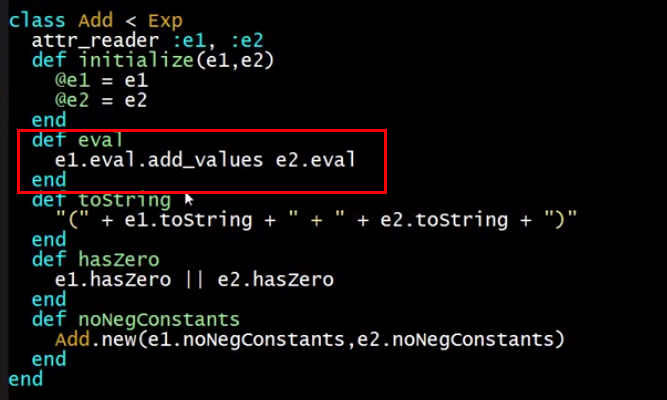
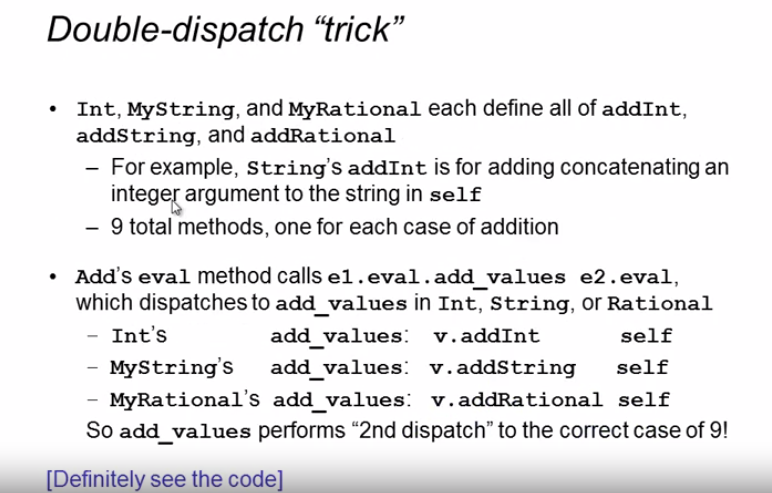
对于静态类型语言例如Java,也同样适用双重分派,所以double-dispatch是一种实现OOP二元操作的重要方法。
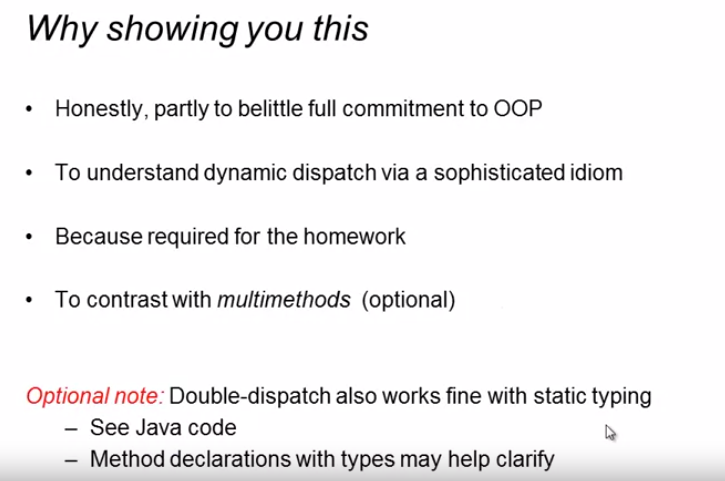
下面看看Java代码:
// Section 8: Binary Methods with OOP: Double Dispatch
abstract class Exp {
abstract Value eval(); // no argument because no environment
abstract String toStrng(); // renaming b/c toString in Object is public
abstract boolean hasZero();
abstract Exp noNegConstants();
}
abstract class Value extends Exp {
abstract Value add_values(Value other); // first dispatch
abstract Value addInt(Int other); // second dispatch
abstract Value addString(MyString other); // second dispatch
abstract Value addRational(Rational other); // second dispatch
}
class Int extends Value {
public int i;
Int(int i) {
this.i = i;
}
Value eval() {
return this;
}
String toStrng() {
return "" + i;
}
boolean hasZero() {
return i==0;
}
Exp noNegConstants() {
if(i < 0)
return new Negate(new Int(-i));
else
return this;
}
Value add_values(Value other) {
return other.addInt(this);
}
Value addInt(Int other) {
return new Int(other.i + i);
}
Value addString(MyString other) {
return new MyString(other.s + i);
}
Value addRational(Rational other) {
return new Rational(other.i+other.j*i,other.j);
}
}
class MyString extends Value {
public String s;
MyString(String s) {
this.s = s;
}
Value eval() {
return this;
}
String toStrng() {
return s;
}
boolean hasZero() {
return false;
}
Exp noNegConstants() {
return this;
}
Value add_values(Value other) {
return other.addString(this);
}
Value addInt(Int other) {
return new MyString("" + other.i + s);
}
Value addString(MyString other) {
return new MyString(other.s + s);
}
Value addRational(Rational other) {
return new MyString("" + other.i + "/" + other.j + s);
}
}
class Rational extends Value {
int i;
int j;
Rational(int i, int j) {
this.i = i;
this.j = j;
}
Value eval() {
return this;
}
String toStrng() {
return "" + i + "/" + j;
}
boolean hasZero() {
return i==0;
}
Exp noNegConstants() {
if(i < 0 && j < 0)
return new Rational(-i,-j);
else if(j < 0)
return new Negate(new Rational(i,-j));
else if(i < 0)
return new Negate(new Rational(-i,j));
else
return this;
}
Value add_values(Value other) {
return other.addRational(this);
}
Value addInt(Int other) {
return other.addRational(this); // reuse computation of commutative operation
}
Value addString(MyString other) {
return new MyString(other.s + i + "/" + j);
}
Value addRational(Rational other) {
int a = i;
int b = j;
int c = other.i;
int d = other.j;
return new Rational(a*d+b*c,b*d);
}
}
class Negate extends Exp {
public Exp e;
Negate(Exp e) {
this.e = e;
}
Value eval() {
// we downcast from Exp to Int, which will raise a run-time error
// if the subexpression does not evaluate to an Int
return new Int(- ((Int)(e.eval())).i);
}
String toStrng() {
return "-(" + e.toStrng() + ")";
}
boolean hasZero() {
return e.hasZero();
}
Exp noNegConstants() {
return new Negate(e.noNegConstants());
}
}
class Add extends Exp {
Exp e1;
Exp e2;
Add(Exp e1, Exp e2) {
this.e1 = e1;
this.e2 = e2;
}
Value eval() {
return e1.eval().add_values(e2.eval());
}
String toStrng() {
return "(" + e1.toStrng() + " + " + e2.toStrng() + ")";
}
boolean hasZero() {
return e1.hasZero() || e2.hasZero();
}
Exp noNegConstants() {
return new Add(e1.noNegConstants(), e2.noNegConstants());
}
}
class Mult extends Exp {
Exp e1;
Exp e2;
Mult(Exp e1, Exp e2) {
this.e1 = e1;
this.e2 = e2;
}
Value eval() {
// we downcast from Exp to Int, which will raise a run-time error
// if either subexpression does not evaluate to an Int
return new Int(((Int)(e1.eval())).i * ((Int)(e2.eval())).i);
}
String toStrng() {
return "(" + e1.toStrng() + " * " + e2.toStrng() + ")";
}
boolean hasZero() {
return e1.hasZero() || e2.hasZero();
}
Exp noNegConstants() {
return new Mult(e1.noNegConstants(), e2.noNegConstants());
}
}
Optional: Multimethods
使用multimethod可以避免使用double-dispatch来实现二元操作(本质上就是方法重载)

使用重载的多个方法,但也存在缺点,容易造成方法调用的混淆。
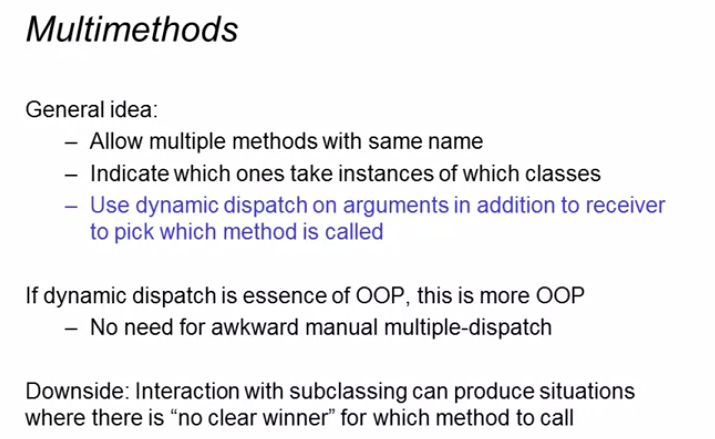
虽然通过不同子类的参数来重载方法在其他语言很常见,但在ruby中很难做到,主要有两点原因:
(1)首先ruby动态类型语言,没有对方法的参数添加类型限制
(2)其次ruby不允许除了覆写以外的同名函数(同名就意味着覆写override,而不是重载overload)

但在其他静态的面向对象语言中,虽然提供了多种方法重载,但只是静态重载。在编写时需要指定静态类型(尽管运行时仍然动态分派)。但这就与我们课程例子所谓的二元操作关系不大了,因为课程中的两个操作对象,可能是Int、Rational或String,但显然在Java等语言中,这个操作对象的类型是确定的。
C# 4.0中加入了动态类型,因此也能够实现multimethod
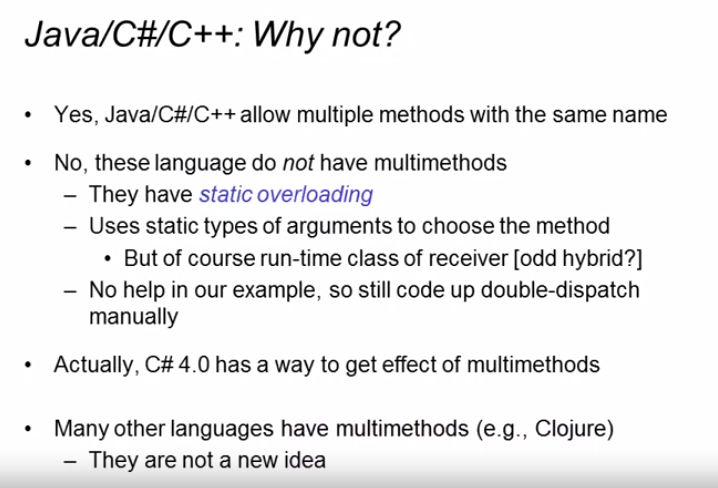
Multiple Inheritance
多继承,也是OOP老生常谈的话题。

多继承的优势和劣势:
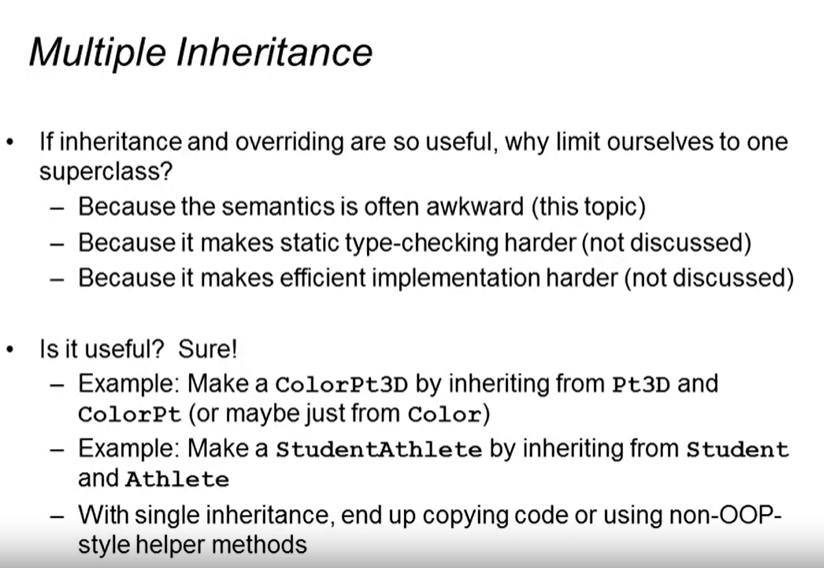
继承结构间可能存在歧义:
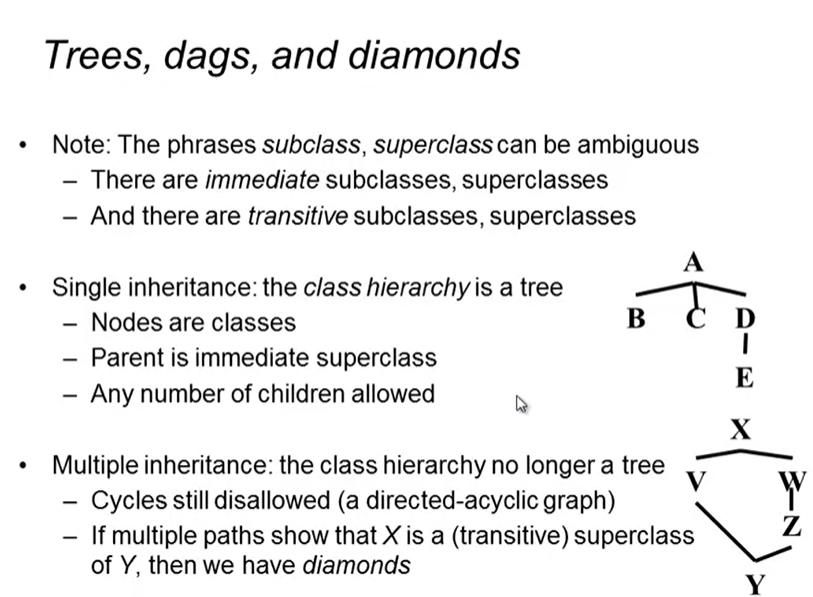
Mixins
mixins是指一个方法的合集,与类的区别在于没有实例。
ruby的modules就是mixins
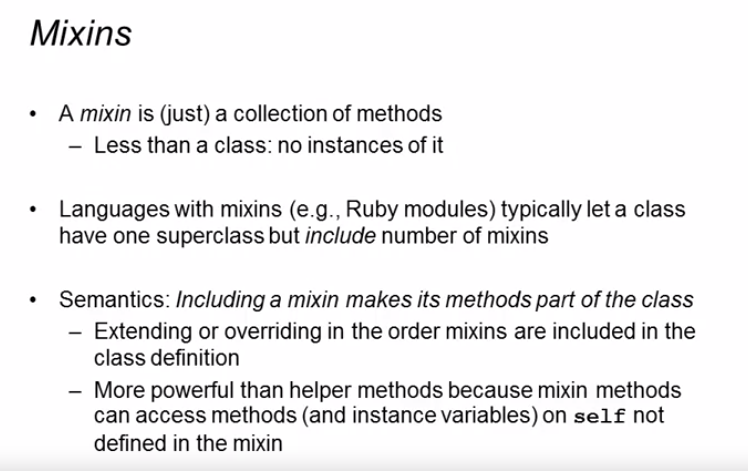
例子:
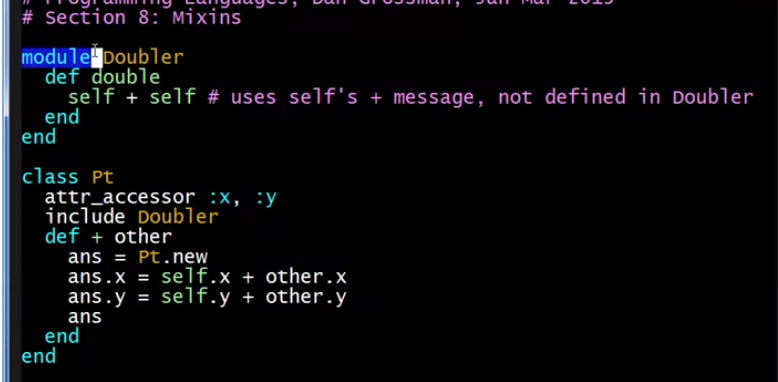
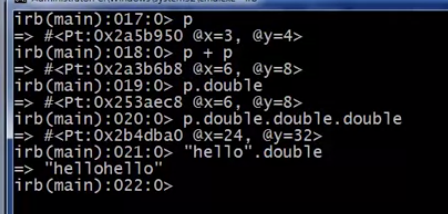
mixin的改变了方法的查找规则,先在类中寻找,然后在mixin中寻找,再在超类中寻找,再在超类的mixin中寻找,以此类推。
对于对象变量,mixin方法可能会造成问题:
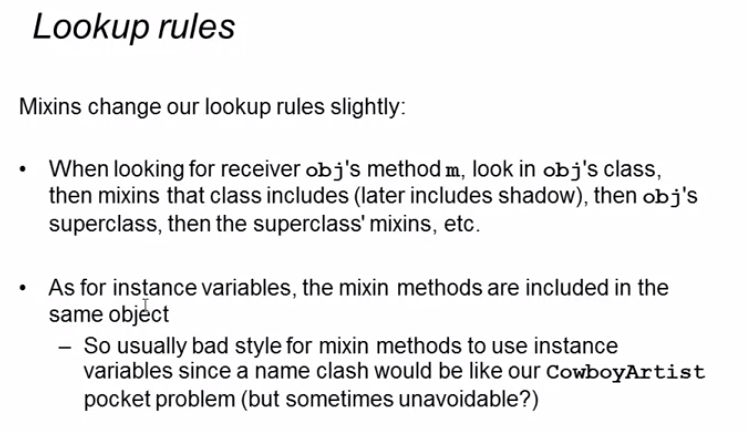
ruby中最有用的两个mixins,Comparable比较和Enumerable枚举。
其中>,<等比较运算符是定义在<=>之上的(即<,>,=等运算调用<=>比较)
其他的迭代器则是定义在each上
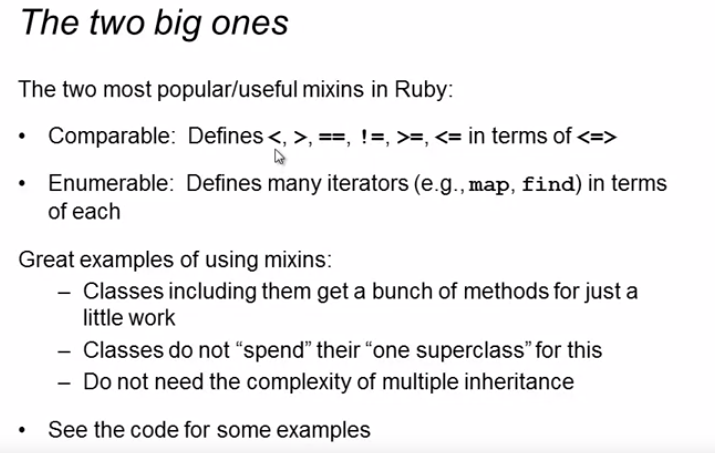
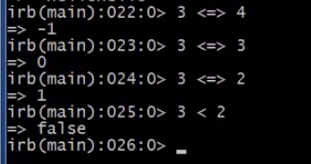
例子:

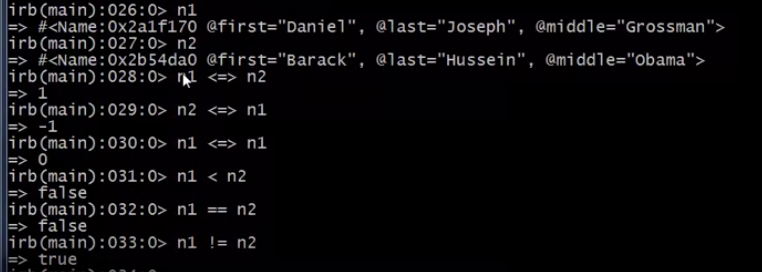
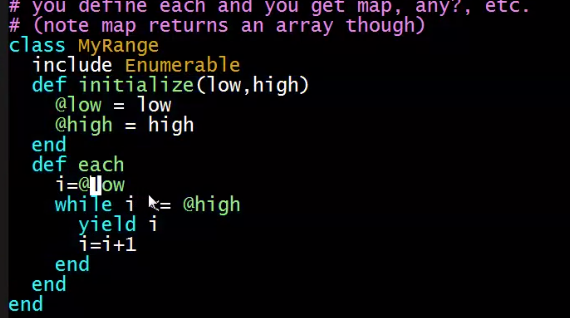
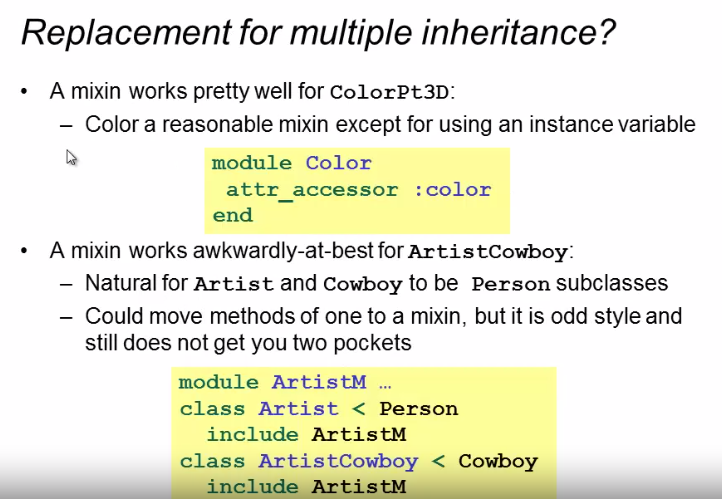
Interfaces
比较多继承与mixins ,和接口的区别
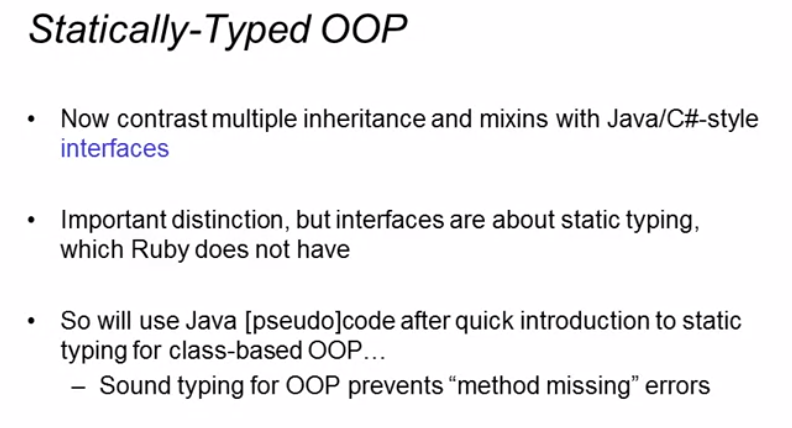
接口的事情学过Java应该都很熟悉了
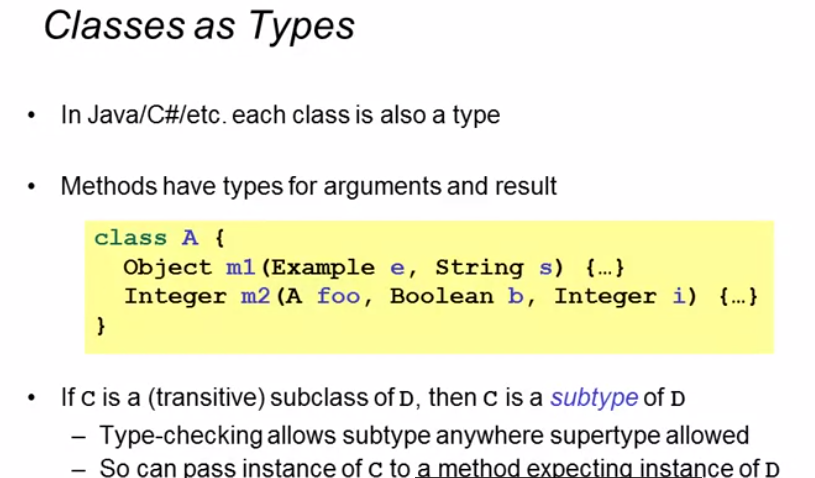
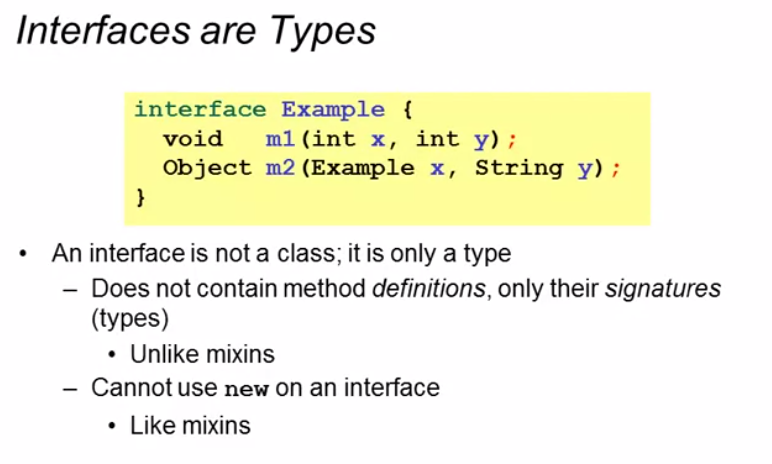
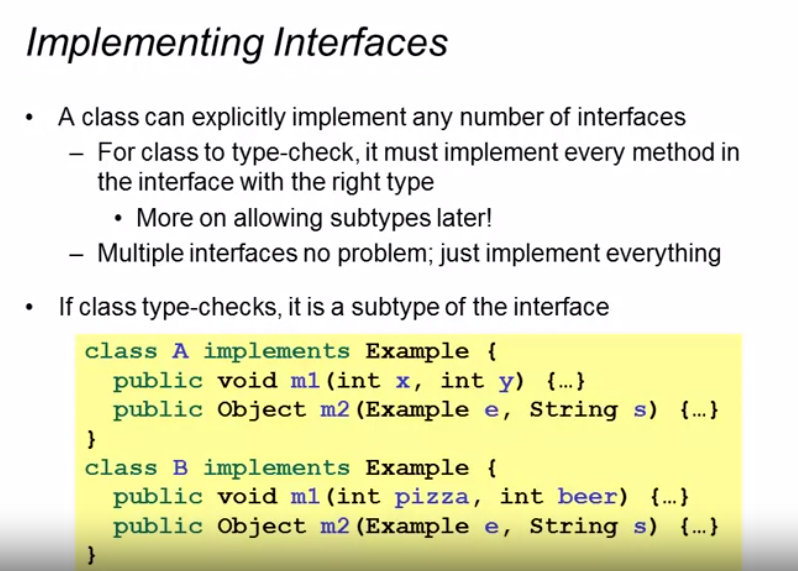
接口可以与mixins共同使用,保证某些方法一定被类实现(例如Comparable需要实现<=>,Enumerable需要实现each)
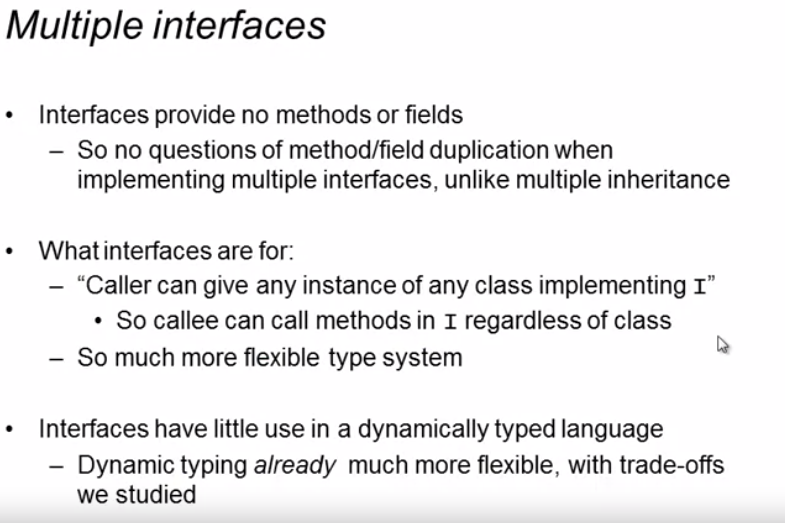
Optional: Abstract Methods
这一节是为了更详细的介绍OOP,所以介绍抽象方法,比如Java的抽象方法和C++的纯虚函数。
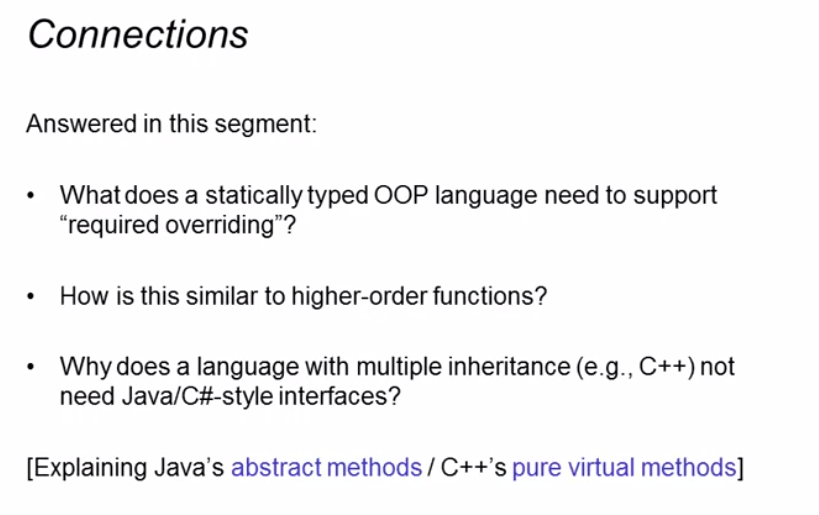
一般会存在超类定义了某些子类必须覆写的方法,在Ruby中我们可以(例如下面的例子),我们可以不定义m2,却直接在m1中使用它,此时的m2就是子类必须定义的内容,并且我们不能单独A.new创建A的实例,否则会method-missing。
值得特别注意的是,在静态语言中是不允许这样做的,父类无法调用只在子类中声明定义的方法;ruby是可以在父类中直接调用只在子类声明定义的方法的,总的来说宽松一些(只有运行时才能判断该方法是否被父类或子类定义)。
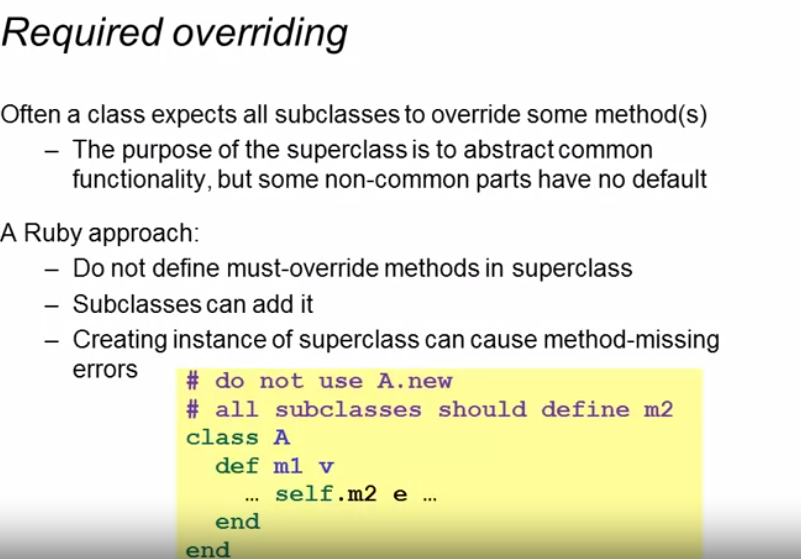
在静态类型语言中,type chcker会保证m2必须在父类中被声明定义,因此我们需要一些多余的语句(例如下面例子的raise语句部分),这样会非常冗余。
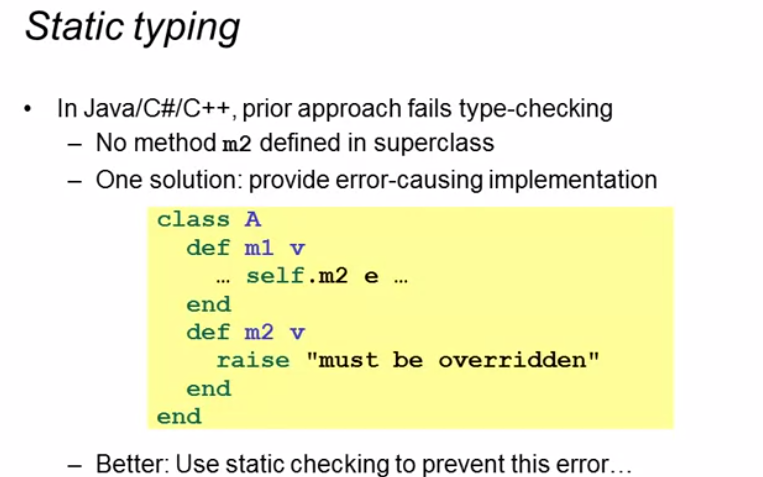
因此有了抽象方法,只声明而不定义,留给子类(每一个子类必须)定义。这样同时也限制了父类的实例创建。
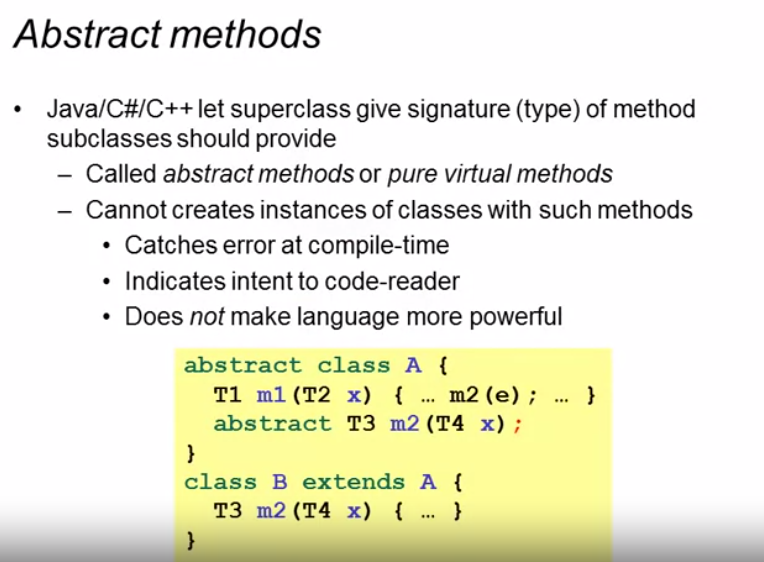
OOP的代码传递与FP的代码传递对比:
OOP的方式:通过子类定义的m2传递到超类的m1中(即使超类m1定义时不会知道m2具体是什么内容,因为m2的定义是运行时才被动态分派的)
FP的方式:高等函数传递代码,高等函数也无法知晓具体内容(例如f中的g,虽然会根据语法认定为函数,但只有运行时才会知晓g具体是什么)。对于定义的f,存在caller(调用者例如h),调用者h提供g的定义,传递到被调用者f中。
总的来说,两者是类似的,都是在超类/callee中定义方法m,这个方法m中包含一些其他方法n(只有运行时才会知道定义的方法),而这个n的定义(额外信息/需要传递的代码)由子类或者caller调用者来提供。
这是一种常用编程手段。
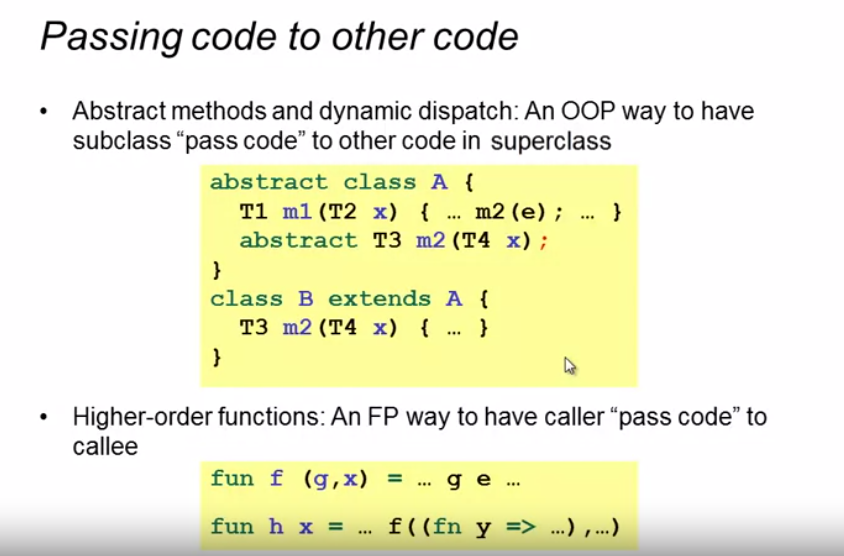
最后讨论没有接口的C++,接口可以通过类与全部抽象方法(纯虚函数)实现,然后接口实现通过类继承(多重继承)来实现。
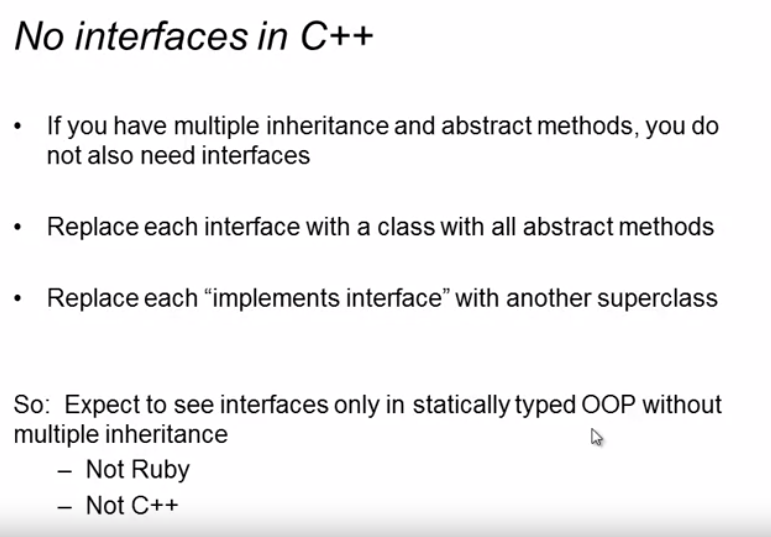
本章也是在介绍面向对象编程的同时对比了函数式编程,总的来说受益匪浅。





【推荐】国内首个AI IDE,深度理解中文开发场景,立即下载体验Trae
【推荐】编程新体验,更懂你的AI,立即体验豆包MarsCode编程助手
【推荐】抖音旗下AI助手豆包,你的智能百科全书,全免费不限次数
【推荐】轻量又高性能的 SSH 工具 IShell:AI 加持,快人一步
· 25岁的心里话
· 闲置电脑爆改个人服务器(超详细) #公网映射 #Vmware虚拟网络编辑器
· 基于 Docker 搭建 FRP 内网穿透开源项目(很简单哒)
· 零经验选手,Compose 一天开发一款小游戏!
· 一起来玩mcp_server_sqlite,让AI帮你做增删改查!!